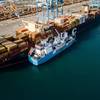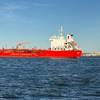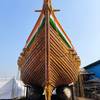Hornbeck Offshore 1Q Report
Hornbeck Offshore Services, Inc. (NYSE: HOS) announced results for the first quarter ended March 31, 2009. Following are highlights for this period and the Company's future outlook:
• Q1 2009 Upstream revenues increased 34% over Q1 2008
• Q1 2009 Upstream operating income increased 52% over Q1 2008
• Q1 2009 Upstream net income increased 49% over Q1 2008
• Three additional DP-2 new gen OSV newbuilds were placed in service during Q1 2009
• First 370 class DP-2 MPSV was placed in service in the GoM in late March 2009
• Company reaffirms growth capex and estimated delivery date guidance for remaining OSVs and MPSVs
• Company reaffirms annual 2009 earnings guidance
• Company adopts APB 14-1 and reports non-cash OID interest expense for current and prior-year periods
First quarter 2009 revenues increased 12.4% to $109.6 million compared to $97.5 million for the first quarter of 2008. Operating income was $45.4 million, or 41.4% of revenues, for the first quarter of 2009 compared to $37 million, or 37.9% of revenues, for the prior-year quarter. Net income for the first quarter of 2009 was $27.1 million, or $1.01 per diluted share, compared to $22.6 million, or $0.84 per diluted share for the year-ago quarter. EBITDA for the first quarter of 2009 was $60.3 million compared to first quarter 2008 EBITDA of $49.2 million. The primary reasons for the increase in revenues, operating income, net income and EBITDA were the incremental contribution of vessels added to the company's fleet since the first quarter of 2008 and favorable new generation offshore supply vessel (OSV) market conditions. For additional information regarding EBITDA as a non-GAAP financial measure, please see Note 10 to the accompanying data tables.
Revenues from the Upstream segment were $90.6 million for the first quarter of 2009, an increase of 34.2% from $67.5 million for the same period in 2008. Upstream operating income increased 52.4% to $44.2 million for the first quarter of 2009 from $29.0 million for the first quarter of 2008. The higher Upstream revenues and operating income were driven by the full- or partial-quarter contributions from seven new generation OSVs and two MPSVs that were placed in service on various dates since the first quarter of 2008, and, to a lesser extent, a market-driven increase in new generation OSV dayrates working internationally. Average new generation OSV dayrates for the first quarter of 2009 improved to $23,085 compared to $21,020 for the same period in 2008. New generation OSV utilization was 93% for the first quarter of 2009, which was in-line with the same period in 2008.
Revenues from the Downstream segment of $19.1 million for the first quarter of 2009 decreased by $11 million, or 36.5%, compared to $30.1 million for the same period in 2008. Downstream revenues were unfavorably impacted by continued lower demand for the company's ocean-going tug and tank barge (TTB) equipment, which resulted in a 35% decline in fleetwide effective TTB dayrates from the year-ago quarter. The company's double-hulled tank barge average dayrates were $20,406 for the first quarter of 2009 compared to $21,781 for the same period in 2008. Utilization for the double-hulled tank barge fleet was 80% for the first quarter of 2009 compared to 91.1% for the same period in 2008. The decrease in the company's double-hulled tank barge utilization was the result of a recent decline in market demand for double-hulled equipment, particularly black-oil barges. The company's single-hulled tank barge average dayrates were $15,710 for the first quarter of 2009, a decrease of $1,227, or 7.2%, from $16,937 for the same period in 2008. This decrease was primarily due to continued soft demand for this type of equipment. In addition, dayrates for the year-ago quarter included the favorable impact of one singled-hulled vessel, which is currently stacked, performing non-traditional tank barge services to Upstream customers at premium dayrates. Single-hulled tank barge utilization was 37.6% for the first quarter of 2009 compared to 81.8% for the same period in 2008. In recognition of the soft market conditions for single-hulled equipment that began in the second quarter of 2008, the company stacked six single-hulled tank barges and three lower-horsepower tugs on various dates since April 2008. Effective single-hulled tank barge utilization, which excludes the impact of stacked tank barges, was 82.7% for the three months ended March 31, 2009. On March 19, 2009, the company sold its oldest stacked tug, the Stapleton Service, for net cash proceeds of $0.9 million, which resulted in a $0.2 million pre-tax gain ($0.2 million after-tax or $0.01 per diluted share).
General and Administrative (G&A) expenses of $8.8 million for the first quarter of 2009 were 8% of revenues compared to $8.6 million, or 8.8% of revenues, for the first quarter of 2008. First quarter G&A expense margin was below the Company's 2009 annual guidance range of 9% to 10% of revenues. The Company allocated 82% of its first quarter G&A expenses to the Upstream segment and 18% to the Downstream segment.
Depreciation and amortization expense was $15.1 million for the first quarter of 2009, or $2.9 million higher than the first quarter of 2008. This increase was driven by incremental depreciation related to the full- or partial-quarter contribution from newbuild vessels that were placed in service since the first quarter of 2008 and the higher cost of regulatory drydock events, partially offset by the reduction in depreciation and amortization following the sale of four conventional OSVs during 2008. Depreciation and amortization expense is expected to continue to increase from current levels as the vessels remaining under the company's current newbuild and conversion programs are placed in service and when these and any other recently acquired and newly constructed vessels undergo their initial 30-month and 60-month recertifications.
Pursuant to the required change in method of accounting for convertible debt instruments required by FASB Staff Position (FSP) No. APB 14-1, "Accounting for Convertible Debt Instruments That May Be Settled in Cash upon Conversion (Including Partial Cash Settlement)," effective January 1, 2009, the company recorded incremental non-cash original issue discount (OID) interest expense, net of capitalized interest, of $0.7 million for the first quarter of 2009, or $0.02 per diluted share, and expects to record $4.8 million for the full-year 2009, or $0.11 per diluted share. In addition, this new accounting treatment requires retrospective application to the Company's historical financial results, including long-term debt and stockholders' equity. For the sequential and year-ago three-month periods ended December 31, 2008 and March 31, 2008, the company recorded incremental non-cash OID interest expense, net of capitalized interest, which resulted in a $0.7 million and $0.02 impact to net income and diluted earnings per share (EPS), respectively, for each such quarter.
The company expects total EBITDA for fiscal 2009 to range between $230 million and $250 million and expects full-year diluted EPS for fiscal 2009 to range between $3.39 and $3.86. Excluding the recently adopted APB 14-1 non-cash OID interest expense, Adjusted EPS for fiscal 2009 is expected to range between $3.50 and $3.97.
The company's forward earnings guidance, outlined above, assumes that current Upstream and Downstream market conditions remain constant. Fleetwide average new generation OSV dayrates are anticipated to be in the $20,000 to $22,000 range and fleetwide new generation OSV utilization is anticipated to average in the high-80% to low-90% range for the annual 2009 guidance period. The Downstream segment is projected to contribute 2009 EBITDA in the range of 6% to 10% of the mid-point of the company-wide 2009 guidance range.
The company's full-year 2009 Upstream guidance includes a partial-year contribution from additional vessels to be delivered under its MPSV program and its fourth OSV newbuild program with the estimated newbuild delivery expectations discussed below. In recognition of substantially reduced demand on the shallow-shelf for conventional vessels in early 2009, the annual 2009 guidance reflects the recent stacking of five conventional OSVs, which the company considers non-core assets. The 2009 Downstream guidance primarily reflects a full-year contribution from the company's fleet of nine double-hulled barges and, to a lesser extent, a full- or partial-year contribution from the company's active single-hulled barges, as applicable.
The company expects that cash operating expenses per vessel-day in fiscal 2009 will not materially increase over fiscal 2008 levels, excluding contract-related costs recoverable through higher dayrates or other revenue. Annual G&A expenses are expected to be in the range of 9% to 10% of revenues for fiscal 2009. The projected annual FAS 123R stock-based compensation expense, depreciation, amortization and net interest expense that underpin the company's diluted EPS guidance for the full-year 2009 are included in the attached data tables. Projected quarterly FAS 123R stock-based compensation expense, depreciation, amortization and net interest expense for the quarter ending June 30, 2009 are expected to be $2.4 million, $11.4 million, $5.9 million and $4.7 million, respectively. The Company's annual effective tax rate is expected to be 36.3% for fiscal 2009.
Update on Maintenance Capital Expenditures. Please refer to the attached data table for a summary, by period, of historical and projected data for each of the following three major categories of maintenance capital expenditures: (i) deferred drydocking charges; (ii) other vessel capital improvements and (iii) non-vessel related capital expenditures. The company expects total maintenance capital expenditures for the full-year 2009 to be approximately $32.6 million. Over the next couple of years beyond 2009, the company expects that its annually recurring maintenance capital expenditure budget, inclusive of regulatory drydockings, for its growing fleet of vessels will range between $40 million and $50 million per year.
The company's MPSV program consists of the conversion of two U.S.-flagged coastwise sulfur tankers at domestic shipyards into 370 class DP-2 new generation MPSVs and the construction of two T-22 class DP-3 new generation MPSV newbuilds in foreign shipyards. The first converted DP-2 MPSV, the HOS Centerline, was placed in service in late March 2009 and the second converted DP-2 MPSV, the HOS Strongline, is expected to be delivered in the fourth quarter of 2009. The first T-22 MPSV, the HOS Achiever, was placed in service in October 2008 and the second T-22 MPSV, the HOS Iron Horse, is expected to be delivered in the fourth quarter of 2009. Based on these projected vessel in-service dates, the company expects to own and operate an average MPSV fleet complement of 2.1 vessels for the fiscal year 2009. Based on internal estimates, the aggregate cost of this program is expected to be approximately $475 million. From the inception of this program through March 31, 2009, the company has incurred $419 million, or 88.2%, of total expected project costs, including $33.4 million incurred during the first quarter of 2009.
The company's fourth OSV newbuild program consists of vessel construction contracts with three domestic shipyards to build six 240 ED class OSVs, nine 250 EDF class OSVs and one 290 class OSV, respectively. Eleven of these 16 new generation DP-2 OSVs have been awarded customer contracts prior to their shipyard delivery. Four of the 240 ED class OSVs under this program, the HOS Polestar, the HOS Shooting Star, the HOS North Star and the HOS Lode Star, were placed in service in May 2008, July 2008, November 2008 and February 2009, respectively. Two of the 250 EDF class vessels under this program, the HOS Resolution and the HOS Mystique, were placed in service in October 2008 and January 2009, respectively. The only 290 class OSV, the HOS Coral, was placed in service in March 2009.
Based on the above schedule of projected vessel in-service dates, the company expects to own and operate 46 and 51 new generation OSVs as of December 31, 2009 and 2010, respectively. These vessel additions result in a projected average new generation OSV fleet complement of 42.9 and 49.1 vessels for the fiscal years 2009 and 2010, respectively. Inclusive of the vessel deliveries referred to above, the aggregate cost of the company's fourth OSV newbuild program is expected to be approximately $450 million. From the inception of this program through March 31, 2009, the company has incurred $311.9 million, or 69.3%, of total expected project costs, including $40.5 million incurred during the first quarter of 2009.
The company believes that its current working capital, available capacity under its existing revolving credit facility and projected cash flows from operations for the fiscal years 2009 and 2010 will be sufficient to meet its anticipated operating needs, as well as the total remaining cash requirements under its MPSV and OSV newbuild programs of approximately $194.1 million. These construction payments are expected to be incurred over the next two years ($158.4 million in the remainder of 2009 and $35.7 million in 2010), as outlined in greater detail in the attached data tables. As of March 31, 2009, the Company had $20.9 million of cash and approximately $100.0 million of credit immediately available under its $250.0 million revolving credit facility. Subsequent to March 31, 2009, the company has drawn an additional $10 million for construction milestone payments. The total amount outstanding under the company's revolving credit facility is currently $160 million. The company is in compliance with all applicable financial covenants of its debt obligations. Its three principal long-term debt obligations do not mature until September 2011, December 2014 and October 2026, the latter of which may, under certain conditions, be subject to early maturity in October 2013.














